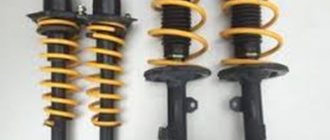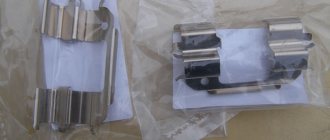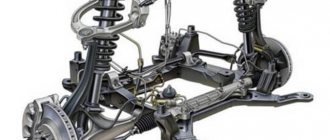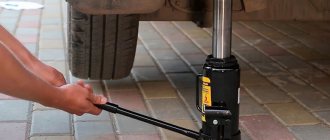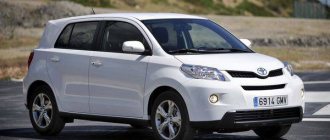As of 2018, the Corolla is the best-selling Toyota car in the world. Therefore, the question of repairing the chassis, and in particular replacing the front struts on a Toyota Corolla 120, is very relevant. Knowing how to recognize a malfunction in time, dismantle it, buy and install high-quality spare parts will help the owner of this unit significantly save time and money.
This article presents detailed instructions and a photo report on replacing the support bearing on a Toyota Corolla in the 120th body and in the 150th, including the stages of removing the part, disassembling it and installing a spare part.
Replacing the support bearing Toyota Corolla 150 - removing the unit
To carry out chassis repair work, we will need a certain list of tools:
- jack or lift;
- a screwdriver or a special puller for plastic parts;
- a set of keys with removable heads from 18 to 26;
- special ties or press for dismantling springs;
When everything is already in hand, you can begin to dismantle the front strut support of the Toyota Corolla.
- We put wheel chocks under the wheels and lift the part of the car we need or the whole car.
- Remove the decorative wheel cap;
- We unscrew the five fastenings of the wheel rim, then dismantle it. The central bolt can be left untouched;
How to identify a malfunction
The support struts of the Toyota Camry car are one of the first to absorb the vibration that occurs when a moving car comes into contact with the road surface, and also help reduce the noise level in the car interior, which can distract the driver in traffic.
Driving a car with faulty support struts does not bring driving pleasure or comfort. Malfunctions in the operation of the struts negatively affect the handling of the car, and also lead to malfunctions of other important units and components of the car: shock absorbers, steering.
Therefore, when the first signs appear, you should immediately diagnose and, if necessary, replace damaged support posts.
It is very important that the condition of the support bearing is constantly monitored, especially on the front struts, which are not very difficult to find. They are located almost above the front wheels of the car. Externally, the strut resembles a rubber gasket with a metal core, inside of which there is a support bearing.
The main methods for determining the malfunction of the support bearing of the Toyota Camry 40:
- When the car is rocked from side to side, you may hear a small, repeating knocking sound.
- When turning the steering wheel in a calm state of the car (the operation is performed by a partner), placing your hand on the hood of the car, light clicks and impacts will serve as evidence of malfunctions.
- When driving, turning the steering wheel requires additional effort and you may hear a squeaking sound.
Once the presence of a malfunction has been determined, it is recommended to proceed with replacing the bearing or strut completely.
Replacing front struts for Toyota Corolla
If the shock absorber has oil leaks, the entire assembly should be completely replaced. Then the work goes a little differently:
- Jack up the car and remove the wheel;
- Unscrew the stabilizer guide;
- Unscrew the steering knuckle bolts;
- Disconnect the brake line and ABS wire;
- Unscrew the top fastening and remove the entire assembly;
- Compress the spring and unscrew the top bolt;
Types of bearings
There are two design versions of the upper part of the rack:
- The support bearing is included in the support design (can be found on a number of VAZ models);
- It is a separate element that is placed between the support and the upper spring cup.
But there are several support bearings themselves that are used in the suspension design:
- WITH BUILT-IN OUTER OR INNER RING. Its peculiarity lies in the possibility of rotation of elements that are in contact with both the outer and inner rings. Additionally, this option provides installation holes, so no pressure flanges are needed during installation;
- WITH DETACHABLE OUTER OR INNER RING. In this embodiment, one of the rings (depending on the design) can be separated, while the second is fixed to the support;
- SINGLE-SPLIT. Structurally, this option is the same bearing with a detachable ring, but has increased rigidity.
In general, there is no particular difference which type of bearing is used, the main thing is that it performs its functions.
Despite the fact that the upper part of the strut is installed inside a special niche in the wheel arch, dirt, sand and dust penetrate the support, and these contaminants are destructive to any bearing.
Additionally, the support bearing is almost constantly subjected to rapidly changing loads, including shock loads (due to the operation of the spring), which, in combination with contamination, leads to intense wear of the bearing components and its failure.
Due to rather difficult operating conditions, the service life of such a bearing is limited. Many manufacturers indicate that it must be replaced every 100 thousand km.
But in reality, due to the poor condition of the roads, they require replacement after 50 thousand km. At the same time, the resource of this node also depends on its quality.
It is not uncommon for a support bearing to be replaced after 10,000 km.
Support bearing Toyota Corolla 120: price and part numbers
There are many options for suitable parts on the market, both original and non-original production. You can save money by choosing parts from another manufacturer. For example, SWAG (81919297) asks about 1300 rubles for the product, and Patron (PSE 4125) - 950 rubles, and SNR KB 669.05 - 1900 rubles.
But it is better to give preference to original spare parts, since they meet the manufacturer’s requirements and can guarantee proper and durable operation of the suspension. The table below will help you decide on the choice of support bearings for the E150.
• E100 (E10) (1992-1997) - 4860912330 • E110 (E11) (1997-2001) - 4860902080 • E120 (E12) (2001-2007) - 4860902130 • E150 (E15) (2006-2013) - 48 60912500
Greetings to everyone who has visited the page.
When the time came for the original support bearings on the Corolla 120, I then decided that I would replace them with Jikiu company number MS21013, the left support bearing clicked after the winter, perhaps it was knocked down by the strut, which completely collapsed that same winter, in the fall when I installed the support bearings they were even more -they worked less... and in the previous blog post I wrote that I replaced the suspension, including the struts that were no longer working...
I rang the VIN and the number 48609-02130 popped up with a price tag of 4700 rubles for 1 piece... naturally this is not an option...
Then I go through the list of substitutes, and start from the Kayaba SM 5215 support with a price of 2723 rubles for 1 piece, where in turn I am given the Original supports for which the Kayaba SM 5215 is used as a substitute, and the main part of the Original support that was given by starting from the Kayaba SM 5215, wasn't on my VIN list...
I choose from the numbers provided the Original props with Toyota number 48609-12420 with a price of 2591 rubles for 1 piece. from the LZFE supplier via EMEX, I sit down at the computer, Google helps, and start looking for “whether it’s right for me at all”...
In the end, I really didn’t find anything, there were entries for other numbers that popped up from the Kayaba SM 5215 props, numbers of some replacements for the props that were in my list according to VIN, and they were also in the list for the Kayaba props...
In general, at my own peril and risk, I ordered 2 original supports with the number Toyota 48609-12420... Waiting time 4 days... status “ready for pickup”... I pick it up, and try it on in the garage with my own tired racks (haven’t thrown it out yet)... and the rod from the strut fits perfectly... I was worried that according to the internal diameter, the strut rod would be either thinner or thicker... I also came across records that in the Original supports that are not displayed according to the VIN, the mounting studs in them may be for different nuts, although the supports are suitable in size , and then my nuts screwed onto the supports as if they were their own...
Causes of failure
The main reasons for the failure of support bearings are dust and water penetrating inside, lack of lubrication there, and also, not rarely, due to a strong impact on the rack. Read more about these and other causes of support bearing failure:
- Natural wear of the part . Unfortunately, the quality of domestic roads leaves much to be desired. Therefore, when operating the machine, be prepared for the fact that the bearings will be subject to more wear than their manufacturer claims.
- Sand and dirt getting inside the mechanism . The fact is that a journal bearing is a type of rolling bearing, and it does not structurally provide protection from the mentioned harmful factors.
- Abrupt driving style and failure to comply with speed limits. Driving on bad roads at high speed leads to excessive wear not only on the support bearing, but also on other elements of the vehicle’s suspension.
- Low quality parts or defects . This is especially true for domestically produced bearings, in particular for VAZ cars.
Front support device
Toyota Camry stabilizer bushings
After a certain time, sadly, every car owner is faced with the annoying need to repair it. The most common cause of clunking noises in the suspension is worn bushings or stabilizer links.
In this article we will look at the design and also tell you how to independently replace bushings and stabilizer struts on Toyota Camry V40 cars.
Consequences of bearing wear and signs of damage
Since the support bearing can be partially attributed to the steering (without it, rotation of the rack would be impossible), its failure primarily affects the controllability.
But here it should be noted that this depends on the design solution used.
For example, in a VAZ-2110, the inner race of the bearing acts as a bushing through which the shock absorber rod passes.
As a result of critical wear of the bearing, it begins to play and the rod is able to deviate from the axis.
The result of this is a violation of the wheel alignment angles, and consequently a deterioration in the car’s handling, as well as accelerated tire wear.
But on a car, where the bearing only provides rotation of the strut and does not interact with the shock absorber, alignment violation practically does not occur, since the rod is kept from axial displacement by a bushing pressed into the rubber damper.
But even with this design, bearing wear will have a negative impact on handling.
If the bearing has worn out, this will naturally begin to show. In this case, the symptoms of a malfunction depend on the design.
If we take the same VAZ-2110, then bearing wear will manifest itself in the form of knocking noises when driving over potholes and unevenness on the road; in addition, they can be heard when turning. Sounds in the support are caused by play in the support element; it is important not to confuse them with a knock in the shock absorber.
In the case of a bearing that does not interact with the shock absorber, its malfunction most often manifests itself in the form of squeaks and squeaks when turning.


